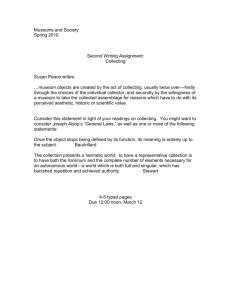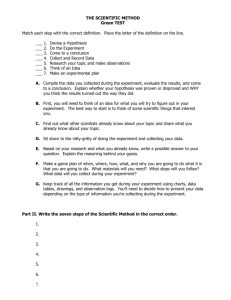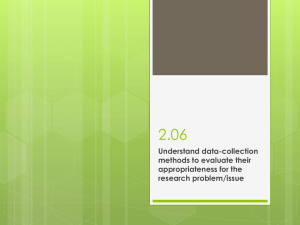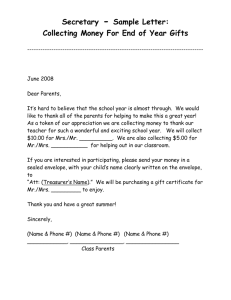1. Formulate questions that can be addressed with data... organize and display relevant data to answer them. Lesson Title
advertisement
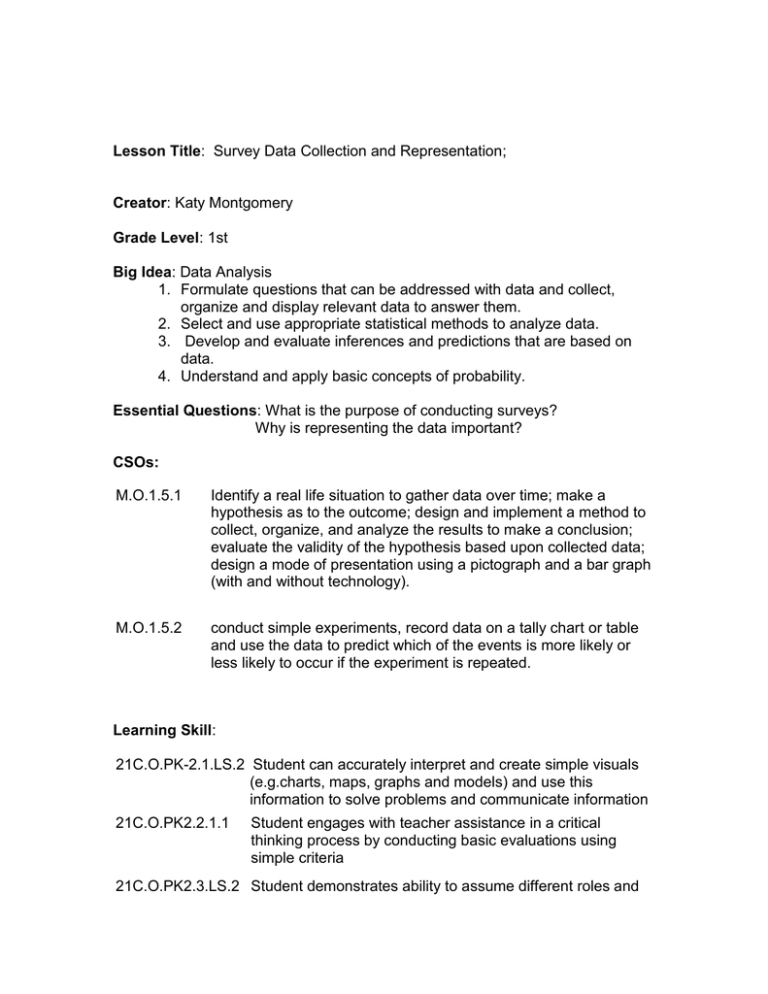
Lesson Title: Survey Data Collection and Representation; Creator: Katy Montgomery Grade Level: 1st Big Idea: Data Analysis 1. Formulate questions that can be addressed with data and collect, organize and display relevant data to answer them. 2. Select and use appropriate statistical methods to analyze data. 3. Develop and evaluate inferences and predictions that are based on data. 4. Understand and apply basic concepts of probability. Essential Questions: What is the purpose of conducting surveys? Why is representing the data important? CSOs: M.O.1.5.1 Identify a real life situation to gather data over time; make a hypothesis as to the outcome; design and implement a method to collect, organize, and analyze the results to make a conclusion; evaluate the validity of the hypothesis based upon collected data; design a mode of presentation using a pictograph and a bar graph (with and without technology). M.O.1.5.2 conduct simple experiments, record data on a tally chart or table and use the data to predict which of the events is more likely or less likely to occur if the experiment is repeated. Learning Skill: 21C.O.PK-2.1.LS.2 Student can accurately interpret and create simple visuals (e.g.charts, maps, graphs and models) and use this information to solve problems and communicate information 21C.O.PK2.2.1.1 Student engages with teacher assistance in a critical thinking process by conducting basic evaluations using simple criteria 21C.O.PK2.3.LS.2 Student demonstrates ability to assume different roles and responsibilities as assigned by the teacher and abandons ineffective strategies when introduced to more effective strategies for solving a problem or completing a task. Technology Tools: used during extension of lesson 21C.O.PK2.1.TT.6 Student, working in a teacher–led whole group project, enters simple data into a spreadsheet and creates graphs electronically (i.e., use of chart wizard). 21C.O.PK2.1.TT.7 Student, working in a teacher-led whole group project, uses presentation software to illustrate concepts and communicate ideas. Launch/Introduction (suggested time 15-20 minutes) Activating Prior Knowledge 1. Say: “Who brushed their teeth and then got dressed this morning?” “Who got dressed first and then brushed their teeth?” “Who is wearing tennis shoes today?” “Who is not wearing tennis shoes?” (kids will raise hands or stand as directed to answer these questions—they are surveys that we have done on previous days) 2. “We have had a great time recently with surveys! Today you will be creating your own survey to use. You are going to decide on a question that has only two possible responses. Then you are going to ask your classmates to answer your survey question and record their responses in some way.” 3. Introduce the prepared chart “Choosing a Question” to the students. (see materials list) Emphasize that the types of questions that will be on the chart have only two possible responses. Brainstorm words that would fit in the blanks for each question on the chart and record them under each blank as choice students can refer to later. Specialized Vocabulary Development: This vocabulary will be presented in the lessons prior to the featured lesson, and will be reinforced or taught according to perceived need: predictable, sure, certain, probably, impossible, unlikely, represent, survey, data, collection, similar, different, discussion. The vocabulary will be introduced initially during morning meeting which includes daily graphing activities such as: lunch count, two dice sum, weather, tooth graph, and tallying days. Investigate/Explore (suggested time 45 minutes) Activity 1: Making a Plan. 1. Arrange the children into pairs (previously thought-out, see teacher notes) and say “You and your partner are going to decide upon a question to ask the other students in our class. Your question will have only two possible responses.” The children may use one of the questions listed on the “Choosing a Question “ chart paper (see materials list) or come up with another one not listed (check the reasonableness of each question chosen and make certain it has only 2 possible responses). 2. Have each pair write their question on the prepared “Plan for Collecting Data” sheet. (see attachment) 3. Place 1 copy of the “Plan for Collecting Data” sheet on an Elmo or other projection device. Post the two prepared planning charts (see materials list) on the board. Bring the children together to discuss making a plan for collecting their data. Say “Now that you have a question to ask, you need to make a plan to administer your survey to your classmates. Administer just means how are you going to do your survey? That is what you have to plan.” 4. Choose a question that none of the partner pairs has chosen to use for demonstration purposes. With the class, fill out the transparency or the data sheet on the projection device modeling how to answer the questions 1 through 3. 5. At question 4, read the question and then ask for ways that student responses could be recorded, listing the examples given by the students on the chart paper labeled “How will you record student responses?” After brainstorming and listing several possible ways of recording responses on the chart paper, choose one idea and record it on the data sheet on the projection device. 6. Follow the above procedure for question 5, first brainstorming and listing possibilities on the chart paper labeled: How will you make sure that you asked everyone?”, then choosing one idea and recording it on the data sheet. 7. Ask for questions, check for understanding of the planning activity and then release the children to plan their surveys. Activity 2: Collecting Survey Data 1. Check each student pairs “Plan for Collecting Data”. If plan is adequate, have the students collect responses to their survey. 2. Have available materials that the students can use for collecting the data including class lists, blank paper, sticky notes, connecting cubes, markers, pencils. 3. As the students work you will act as facilitator, checking with student pairs and asking questions that may help students with perceived difficulties. “How can you figure out how to keep track of whom you have surveyed and whom you have not?” “Would a class list help you?” “How will you record an answer that is different from the two choices that you gave?” Activity 3: Creating a Representation 1. Students will discuss ways to organize and display the data they collected from their surveys. 2. Students will create a representation of their findings. Summarize/Debrief the Lesson (suggested time from 15-20 minutes) Gather the children on the floor or rug in a circle so that everyone can see and hear everyone else. Partner pairs will share the results of their work. Reflections: Questions for debriefing: How did you keep track of everyone in the class? How did you make certain that you asked everyone? Can you tell whether your representation has a piece of data for each student you surveyed? How would someone else tell from your representation how many students chose_____? What did you find out from your survey? How does your representation show that? What method of recording your classmates’ responses worked best for you? What was difficult about collecting responses to your survey? How did you solve any problem that you had? How did you organize your survey results? What can you tell me about your work? What would you do differently next time? What is the purpose for conducting surveys? Why is representing data important? Materials: Prepared Chart: “Choosing a question” Put the following headings on a piece of chart paper: “Would you rather ______________or __________?” ; Which do you like better: __________ or ____________?”; “Do you __________or _________?” ; “ Which is harder for you: ______________or_____________?” “Are you _______or___________?”; Leave enough room under each heading for several examples Planning Chart Write the title “How will you record students’ answers?” at the top of a piece of chart paper. Planning Chart Write the title “How will you make sure that you asked everyone?” at the top of a piece of chart paper. partner pairs pre-selected “Plan for Collecting Data” sheet 1 for each partner pair and 1 for teacher Class list of students Make copies, 1 per student. Clipboards Connecting cubes options for student representations Sticky notes options for student representations Crayons or Markers or other materials for making representations Elmo/Document Reader http://nces.ed.gov/nceskids/createagraph/default.aspx (lesson extension) Duration: 90 minutes or two 45 minute sessions Teacher Notes: This lesson comes from the Investigations Curriculum, Unit 4, Data Analysis, Investigation 2, session 2. 3, and 2.4 with some adaptations and additions. Prior to this lesson the children completed other investigations that gave them experience in using surveys and recording data. Before today’s lesson, the teacher should group the children into pairs, making certain to consider each partner pair’s learning style and ability as well as work ethic. A note of caution: do not group the top student with the lowest student but rather list the children by ability and then group the children into compatible pairs. If you have 20 students, for example, group #1 with #11, #2 with #13 and so on. Learning to collect data, to use it for understanding, to communicate findings and to make representations are critical skills for children to develop. There are many standard and nonstandard forms for both collecting and representing data. Children need to explore ways to collect and represent, learn the standard forms of representation, and become aware that talking about how things are organized, interpreted and understood are key. Unless children develop these skills, they will not have a complete idea of how statistical data works. What is most critical for young students is to keep connecting their data, and the representations of their data, to what it represents. Students can easily become focused on the number of check marks or pictures or other symbols they have made and lose track of what these symbols represent. In this investigation, the children develop their own survey questions, make a plan for gathering data, and collect and record responses to these surveys. As an extension of this lesson, the children will be graphing the results of their surveys using http://nces.ed.gov/nceskids/createagraph/default.aspx or some other means of representing their survey results. Appendices: Our Plan for Collecting Data Student Sheet Name______________________________Date__________________ Our Plan for Collecting Data 1. What is your question? _____________________________________________ _____________________________________________ _____________________________________________ 2. Who will ask the question? _____________________________________________ _____________________________________________ _____________________________________________ 3. Who will record the students’ responses? _____________________________________________ _____________________________________________ _____________________________________________ 4. How will you record students’ responses? _____________________________________________ _____________________________________________ _____________________________________________ 5. How will you make sure that you asked everyone? _____________________________________________ _____________________________________________ _____________________________________________

